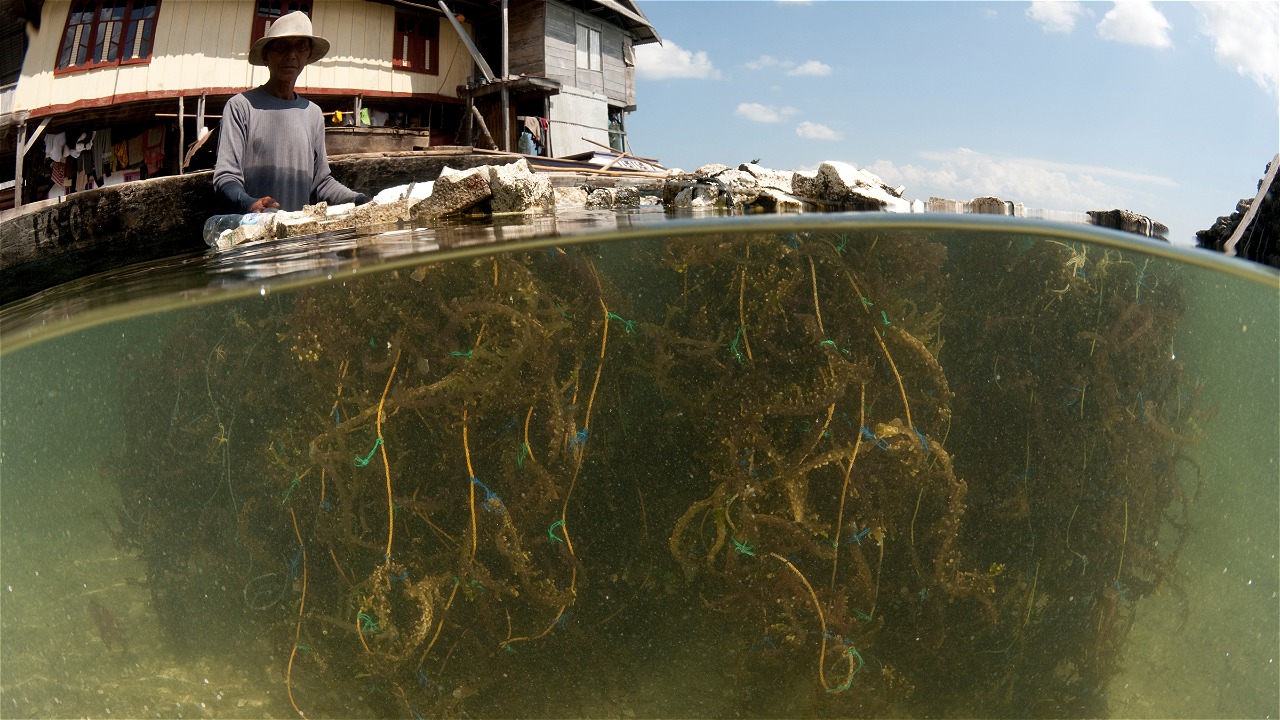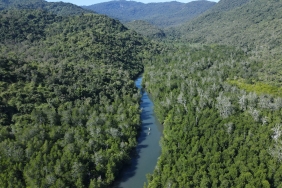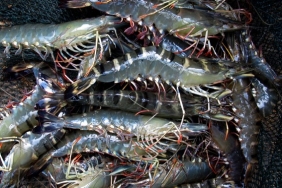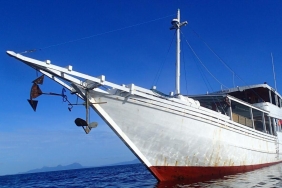WATER QUALITY STUDY REVEALS CAUSE OF KOTONI SEAWEED FAMINE IN WAKATOBI
"By: Idham Malik (Aquaculture Staff, WWF-Indonesia)
Since 2012, seaweed farmers in Wakatobi, Southeast Sulawesi have been busy switching commodities, from kotoni (Kappaphycus alvarezii) to spinosum (Eucheuma spinosum). The trigger is because spinosum has a fairly high price and is equivalent to the average price of kotoni, which is Rp. 8,000. In addition, seaweed cultivation is quite fast to harvest. However, the exact cause of the move was because cotoni cultivation was no longer promising for the cultivators.
"The islands in Wakatobi are small islands that do not have large rivers that usually supply organic materials. There are also not many agricultural and plantation activities. So, the supply of organic materials from land (fertilizer residues and livestock manure) is less available in Wakatobi," said Dr. Ir. Nursidi Latief, M. Si, from Politani Pangkep, in the Socialization Seminar on the Results of Data Collection on Water Quality of Wakatobi Seaweed Cultivation Area at Wakatobi Hotel (29/08/2018) in Wanci, Wakatobi, Southeast Sulawesi. This seminar is a socialization of the results of the environmental carrying capacity data collection program from the WWF-Indonesia marine science team.
"The lack of nitrate content is the key reason for the difficulty of kotoni seaweed growth in Wakatobi waters," he continued in front of seminar participants, namely seaweed cultivators in Wanci and Kaledupa Islands and stakeholders Dinas Kelautan dan Perikanan (DKP) Wakatobi and Wakatobi National Park.
Nitrate is important because it is one of two compounds (nitrate and phosphate), which is the source of energy for seaweed algae. If the nitrate content in the water is below standard, the seaweed grows slowly and dies quickly.
Kotoni cultivation only survives in a few locations in Wakatobi, such as a small part in Derawa and Langgea, Kaledupa Island, most cultivation areas can only produce cultivation during certain seasons, generally the rainy season. When the rainy season passes, kotoni are generally attacked by ice - ice or cat hair disease, which makes growth slow and eventually die.
Cultivators harvest what they have and there is no more seed stock for the next cultivation. This required farmers to go back and buy seedlings at another location, which cost them money.
In the 1980s-1990s, cotoni cultivation seemed to have no problems in Wakatobi. Ice disease was not yet prevalent and farmers could routinely harvest their crops throughout the year, apart from during the dry season, when they only raised seaweed seedlings. Farmers admit that since 2009, the disease has started to appear, along with the increasing quantity of seaweed stocked in the sea.
Lack of Nitrate in Waters, Cause of Kotoni Death in Wakatobi
It appears that Wakatobi's ocean capacity can no longer accommodate large quantities of kotoni seaweed. What are the causes and solutions?
To uncover the causes, data collection was conducted using water quality tools to record the water quality of aquaculture areas. For example, a DO meter to measure the oxygen content in the water, a pH meter to measure the acidity of the water, and a handrefractometer to measure the salt content in seawater.
In August 2017, systematic data collection of water quality in the villages of Liya, Sombano, Horuo, Balasuna, Langge, in collaboration with Dr. Ir. Nursidi Latief, M. Si. from Politani Pangkep, began. In addition to data on DO, pH, and Salinity, data on nitrate and phosphate content in these waters were also collected for eight months, from October 2017 to May 2018.
From the results of nitrate and phosphate data analysis conducted at the Haluoleo University Water Quality Laboratory, Kendari, it was found that the nitrate content of all seaweed cultivation areas showed numbers below the optimum standard for kotoni cultivation, which requires the nitrate content of waters between 0.9 - 3.5 ppm, with a minimum content of 0.1 ppm. From the data compiled by Nursidi, it was found that the waters of Wakatobi generally only contain between 0.03 - 0.08 ppm.
Only in January 2018, in Langge and Balasuna villages, the water area contained 0.1 ppm nitrate. According to Nursidi, looking at the condition of Wakatobi waters, "We cannot measure the carrying capacity of the environment or carrying capacity, because in reality Wakatobi waters are not suitable for kotoni cultivation."
Natural Conditions, Another Cause of Kotoni Death in Wakatobi
In addition to the lack of nitrate content in the waters, there are two other factors that inhibit the development of kotoni seaweed cultivation in Wakatobi. According to data from the Wakatobi island currents, when the tide comes from the west and when it recedes, the wind comes from the east, and vice versa. So, in Wakatobi there is a rotation of wind back and forth very quickly. Thus, seawater as a medium for seaweed cultivation is not replaced by seawater from the vast ocean. It is estimated that the water goes back and forth around the seaweed cultivation area.
In addition, the climate type in Wakatobi is a type C climate, which means the amount of rain intensity is small. In fact, one of the factors that encourage the supply of organic matter is rain. Rain that falls on the land, makes the flow of water from the land carry organic matter from the land.
It seems that Wakatobi seaweed farmers really need to make peace with the death of cotoni in Wakatobi and optimize responsible spinosum cultivation.
Read More: Mapping Solutions for the Improvement of Seaweed Farming in Wakatobi
"





